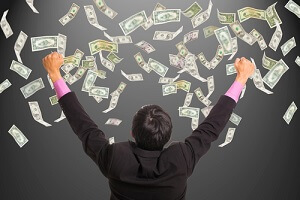 Most people don't know we just got a rare chance to celebrate victory against big banks. Break out the sparklers and cake - this isn't an opportunity you'll want to miss...
Most people don't know we just got a rare chance to celebrate victory against big banks. Break out the sparklers and cake - this isn't an opportunity you'll want to miss...
Last week, our nation's biggest banks lost a portion of an outrageous handout they've been garnishing from American taxpayers for the last 102 years.
This free handout is a ploy seldom covered by mainstream media - which, as we all know, is now generally loath to upset the powers that be.
It happened Tuesday, when Congress released a highway bill that uses surplus funds from the U.S. Federal Reserve to help pay for the legislation's $325 billion price tag.
These surplus funds will drain the source of this big-bank payout, known as Federal Reserve dividends...
What Are Federal Reserve Dividends?
Right now, roughly 38% of the 8,039 commercial banks in the United States are members of the Federal Reserve System. National banks must be members by law. State-chartered banks can join if they meet certain requirements.
These member banks are required to hold 3% of their capital as stock in their reserve banks.
Since its founding in 1913, the Fed has paid out a 6% dividend per year on the stock the banks buy to become members in the Federal Reserve System.
Federal Reserve dividends were originally an incentive to get banks onboard with the newfangled central bank idea.
Now it's just a 6% risk-free, tax-free gift from you, the taxpayer, to the Wall Street banks responsible for the 2008 financial crisis, among other offenses.
"Fed dividends are risk-free, free money given to Wall Street banks from the taxpayers, directly or indirectly," Money Morning Special Contributor and Wall Street Examiner publisher Lee Adler said on Dec. 3. "It's yet another example of the perverse incentives that the central bank has made a part of its policy. And the outcomes are perverse. The Fed is punishing America's savers and rewarding the big banks' often reckless, and sometimes criminal, behavior with risk-free income."
JPMorgan Chase & Co. (NYSE: JPM), which has held Fed stock since its inception, has made back its investment six times over without risking any loss, according to The Intercept.
Meanwhile, American taxpayers get CD rates under 1%. Nor will they ever enjoy a risk-free dividend of any amount.
"Any time the Federal Reserve pays private banks a subsidy, clearly it's outrageous," Adler said. "Any of the Fed's surplus - its profit - gets returned to the taxpayers. That reduces taxes. Now - divided among all taxpayers - the reduction wouldn't be much. But it's the principle of the thing. They've been handing it over to banks. Why should U.S. taxpayers be paying to reward banks? And to what end?"
While the new highway bill won't altogether do away with Federal Reserve dividends, it does slash them down from 6%...
How the Highway Bill Is Making Big Banks Squirm
The highway bill that came out on Tuesday provides $281 billion in contracting authority over five years for the Highway Trust Fund for roads, bridges, mass transit, and other programs. It allocates more than $10.36 billion for rail-related projects, and $980 million for the National Highway Safety Administration's safety provisions, to name just a couple of the intended projects.
[mmpazkzone name="in-story" network="9794" site="307044" id="137008" type="4"]
To pay for the expense, the Federal Reserve dividend given to big banks will be cut from 6% to a percentage tied to the 10-year U.S. Treasuries. Right now that yield is about 2.3%. Should Treasury yields rise, the dividend is capped at 6%.
According to The Intercept, rough estimates suggest the dividend reduction will bring in between $8 billion and $9 billion over the 10-year time frame (around half the original figure).
Of course, big banks hate the idea.
"This proposal is misguided and undermines a key agreement that has underpinned the U.S. banking system for a century," American Bankers Association President and Chief Executive Officer Rob Nichols said in a statement. "Banks shouldn't be used like an E-Z Pass to pay for highways."
But the banks are still getting a sweet deal - just not quite as sweet as before.
First, the dividend reduction applies only to banks with more than $10 billion in assets.
Second, other provisions in the bill actually loosen parts of financial industry securities regulations and some Dodd-Frank laws.
And third, at the end of the day, these big banks are still getting a risk-free dividend at the expense of the taxpayer.
"Six percent is a symbolic issue. It's been around forever and is taken for granted, but it's bad policy," Adler said. "I think it's great that Congress is finally moving on this, but even at the 10- year Treasury yield, there's no risk. This is clearly a case of the taxpayers subsidizing the banks again. Let's not forget that we are also paying the banks interest on excess reserves, term deposits, and reverse repos. The interest the banks receive on these instruments is on money that the Fed literally created and pumped into the banks. They were not funds the banks earned. It was free money to them."
"And now the Fed," Adler continued, "is promising to increase these other subsidies. Reducing that 6% dividend seems like the least Congress can do. The public needs to wake up and step up the pressure on Congress to rein in the Fed subsidies to the banks."
Tweet the author @TaraKateClarke, or leave a comment on Money Morning's Facebook page.
The Stock Buyback Con Game: Stock buybacks make sense for some companies, but not for all. These days, they're often used to manipulate stock prices - and they've hit record levels lately. What's driving this growth is dangerous for you and our economy...
Related Articles:


